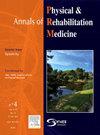欧洲轻度创伤性脑损伤后12个月内缺勤:一项CENTER-TBI队列研究。
IF 4.6
3区 医学
Q1 REHABILITATION
Annals of Physical and Rehabilitation Medicine
Pub Date : 2025-09-30
DOI:10.1016/j.rehab.2025.102017
引用次数: 0
摘要
背景:以往关于轻度创伤性脑损伤(mTBI)后缺勤的研究大多样本量小,随访评估数量有限。目的:因此,本研究调查了欧洲mTBI后12个月内缺勤的发生率、轨迹和相关因素。方法:数据来自欧洲队列(CENTER-TBI)。在mTBI后2周、3个月、6个月和12个月评估缺勤情况。相关因素包括社会人口学因素、当前精神活性物质使用、损伤前病史、损伤相关因素、医疗护理、并发症和出院,以及2周随访问卷。推论分析依赖于广义估计方程。结果:本研究纳入了1080名受伤时正在工作的成年mTBI患者(中位[IQR]年龄46.0[23.0]岁;69%为男性)。工伤缺勤率从2周时的32%下降到12个月时的20% (P < 0.001)。大约76%的成年人在前3个月内重返工作岗位,而在3个月缺勤的人中,有43%的人在12个月后仍然缺勤。与缺勤最相关的3个因素是住院(OR = 2.57)或重症监护病房(OR = 4.76)、伤前精神障碍(OR = 2.55)和年龄较大(OR = 1.61)。结论:五分之一的mTBI患者在受伤后12个月缺勤。早期识别那些特别有可能无法重返工作岗位的人应该是临床的优先事项。研究注册:NCT02210221 (https://clinicaltrials.gov/)。本文章由计算机程序翻译,如有差异,请以英文原文为准。
Absence from work in the 12 months following mild traumatic brain injury in Europe: a CENTER-TBI cohort study
Background
Most of the prior research on absence from work after a mild traumatic brain injury (mTBI) was of a small sample size and had a limited number of follow-up assessments.
Objectives
Therefore, this study investigated the prevalence of absence from work, trajectories, and associated factors in the 12 months following mTBI in Europe.
Methods
Data from a European cohort (CENTER-TBI) were used. Absence from work was assessed at 2 weeks, 3 months, 6 months, and 12 months after mTBI. Associated factors included sociodemographic factors, current psychoactive substance use, pre-injury medical history, injury-related factors, medical care, complications, and discharge, and 2-week follow-up questionnaires. Inferential analyses relied on generalized estimating equations.
Results
This study included 1080 adults with mTBI who were working at the time of the injury (median [IQR] age, 46.0 [23.0] years; 69 % men). Absence from work decreased from 32 % at 2 weeks to 20 % at 12 months after the injury (P < 0.001). Around 76 % of adults returned to work within the first 3 months, whereas > 43 % of those absent from work at 3 months remained absent at 12 months. The 3 factors with the strongest association with absence from work were admission to hospital wards (OR = 2.57) or intensive care units (OR = 4.76), the presence of a pre-injury psychiatric disorder (OR = 2.55), and older age (OR = 1.61).
Conclusions
One-fifth of workers with mTBI were absent from work 12 months after the injury. Early identification of those at particular risk for not returning to work should be a clinical priority.
Study registration
NCT02210221 (https://clinicaltrials.gov/).
求助全文
通过发布文献求助,成功后即可免费获取论文全文。
去求助
来源期刊

Annals of Physical and Rehabilitation Medicine
Medicine-Rehabilitation
CiteScore
7.80
自引率
4.30%
发文量
136
审稿时长
34 days
期刊介绍:
Annals of Physical and Rehabilitation Medicine covers all areas of Rehabilitation and Physical Medicine; such as: methods of evaluation of motor, sensory, cognitive and visceral impairments; acute and chronic musculoskeletal disorders and pain; disabilities in adult and children ; processes of rehabilitation in orthopaedic, rhumatological, neurological, cardiovascular, pulmonary and urological diseases.
 求助内容:
求助内容: 应助结果提醒方式:
应助结果提醒方式:


